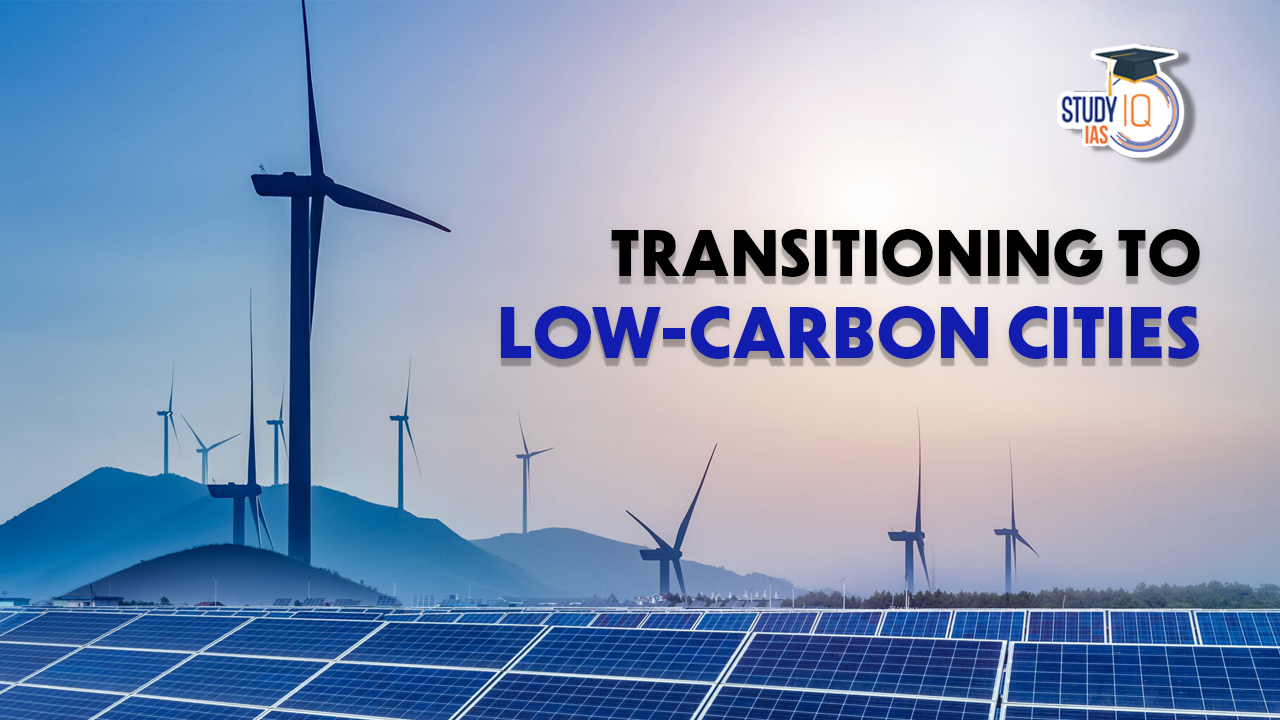Table of Contents
Context: Due to the impact on environment, low-carbon cities are crucial to mitigate the effects of climate change.
More on the News
- In 2020 alone, cities emitted 29 trillion tonnes of carbon dioxide into the atmosphere. This makes their critical in climate change.
- Transitioning to low-carbon or even net-zero cities requires integration of mitigation and adaptation options in multiple sectors through a measure known as ‘sector-coupling approach’.
What is Energy-System Transition?
- Energy-system transition or energy transition is a broad shift in technologies and behaviors that are required to replace one source of energy with another. The current energy transition is mostly aimed at moving away from fossil fuel-based production and consumption model.
- Drivers of current energy-system transition:
- Climate change: The rise in global temperatures and the subsequent changes in climate have forced the global community to actively pursue energy transition goals.
- Energy security: Many countries are trying to reduce dependence on energy imports in form of fossil fuels. This has forced them to adopt other sources of energy.
- Long term economic benefits: The cost of energy generated through renewable energy sources such as solar and wind has drastically reduced. On a long term, these investments will save significant import cost of fossil fuels.
- Development: New energy sources have the capability to generate employment, industrial growth and brings development.
- Health benefits: Transition to clean energy will lower the number of premature deaths caused by air pollution and reduce health costs.
- Implementation of energy-system transition: Transition must occur both on the demand and the supply side.
- Supply side mitigation measures include phasing out fossil fuels and increasing the share of renewables in the energy mix and using carbon capture and storage (CCS) technologies.
- Demand side mitigation would include ‘avoid, shift, improve’ framework to reduce the demand for materials and energy, and substituting the demand for fossil fuels with renewables.
- Carbon-dioxide removal (CDR) technologies must be implemented to address residual emissions in the energy sector.
Strategies for Low-Carbon Transition
- Policy overhaul: Policies that help in reducing carbon footprint must be at the centre of strategy. Policies must be framed by considering city’s spatial form, land-use pattern, level of development, and the state of urbanization.
- Recycling and repurposing: Cities can retrofit and repurpose its infrastructure to increase energy efficiency and reduce unnecessary carbon emission.
- Promote public transport: City authorities must promote public as well as active transport like bicycling and walking. Usage of individual vehicles must be discouraged.
- Renewable energy usage: Cities can electrify public transport and set up renewable-based district cooling and heating networks. This will reduce usage of excess fossil-fuel based electric energy.
- Collocating housing and jobs: Cities must be designed in such a way that places of work must be closer to residential complexes, thus reducing transport energy demand.
- Green building codes: New emerging cities can mandate building codes that mandate net-zero energy use and retrofit existing buildings that use low-emission construction material.
Issues concerning energy transition
- Economic burden on developing countries: Hurried transitioning to renewable-energy sources may disproportionately affect groups of people or communities in developing economies, who are excessively dependent on fossil fuel-based energy.
- Dispossession of land for renewable energy projects: Large-scale renewable energy projects, such as solar energy parks, could dispossess communities of their lands, thereby affecting their livelihoods.
- Revenue of developing countries: Many under-developed and developing countries in Africa are heavily dependent on fossil-fuel exports for generating revenue.
- Transitioning away from fossil fuels could devastate their economies, with severe consequences on the workers employed in the fossil-fuel sector.
- Energy poverty: Many communities in developed countries suffer from energy poverty and inequity due to high energy costs, low incomes, and inadequate infrastructure.
- This can crowd out expenses for other facilities like healthcare and nutrition.
Way Forward
- Ensuring a smooth transition to low-carbon energy systems in cities requires strategic and bespoke efforts. The transition must be socially inclusive, aimed at eradicating poverty.
- Efforts in this regard must be directed at governance and planning, achieving behavioral shifts, promoting technology and innovation, and building institutional capacity.
- There is a need for efforts to address the root causes of energy and environmental injustices. This includes mitigation and adaptation responses that engage multiple stakeholders in energy governance and decision-making, promoting energy-efficiency, enhancing climate investments, and adopting indigenous knowledge system.
Global Energy Transition Index
- World Economic Forum’s Global Energy Transition Index measures 115 countries’ readiness to shift to stable, efficient, accessible, and inclusive energy systems.
- Dimensions:
- Economic development and growth
- Sustainability
- Energy protection and access
- In the 2021 index, India is ranked at the 87th position among 115 countries.


 Bharat Bandh 9 July 2025: Over 25 Crore ...
Bharat Bandh 9 July 2025: Over 25 Crore ...
 UPPSC Mains Question Paper 2025: Downloa...
UPPSC Mains Question Paper 2025: Downloa...
 Sukhoi Su-57: Will India Choose Russia�...
Sukhoi Su-57: Will India Choose Russia�...





















